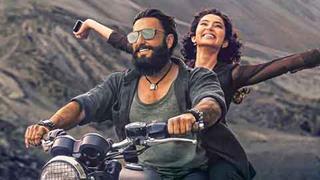Salman Khan will be seen in the distinctive Thai rickshaws performing action scenes for upcoming film, Ready
Salman Khan recently shot some high-voltage action sequences while driving a tuk-tuk in the narrow streets of Pattaya, Thailand last week.
Perhaps inspired by Hollywood actor Pierce Brosnan's fast-paced ad in the ubiquitous Thai rickshaw, Khan suggested to the director Anees Bazmee that they shoot some action scenes in one, as it hasn't been done
in a Hindi film as yet.
Spiralling costs
Subsequently, an action scene was written and shot, showing two tuk-tuks blowing up and the actor jumping into another one and driving off. Says an insider, "Since no owner wanted to have his vehicle blown up,
producer Bhushan Kumar had to buy three at a cost of approximately R 2 lakh each, for the shoot. Salman drove the tuk-tuk expertly, although it was his first time doing so."
Understandably, Bhushan and co-producer Rajat Rawail want only the best for this R 57 crore extravaganza. No expenses are being spared. After Wanted and Dabangg, Khan's fans want to see him in bigger and
better action scenes and the producers aim to deliver.
That said, this is T-Series' most expensive film to date. The shoot in Bangkok and Pataya itself is costing Bhushan over R 11 crore at a cost of R 25 lakh per day. Special Thai action fighters have been hired to shoot
the action scenes in the tuk-tuks in Bangkok and in the entire film."
Bhushan admits, "It was bhai's (Salman) idea to shoot in a tuk tuk. Unlike the two and three-wheeler vehicles in India, the tuk tuks are very fast and powerful. Their drivers too are experts and can ride them as two-
wheelers also.
Bhai wanted to shoot an action sequence nobody has done before. People have shot romantic songs or scenes perhaps, but such a high-voltage action sequence will be seen for the first time in ready. People will
enjoy this unique Thai action."
About a tuk-tuk
Similar to a taxi in utility is Thailand's ubiquitous tuk-tuk. So named because of the sound of their engine, these are motorised rickshaws and are popular amongst tourists for their novelty value. They are occasionally
faster than taxis in heavy traffic as weaving in and out is easier, but generally are about the same or slower.
As tuk-tuks are open-ended, they expose passengers to the high pollution levels in the middle of Bangkok's roads and offer almost no protection in case of an accident. There is theoretically a ban on new tuk-tuks as
they are so noisy and polluting, but it doesn't really seem to be enforced at present.
First Look: Salman blows up three tuk-tuks in Pattaya
Tuesday, February 22, 2011 12:53 IST


















